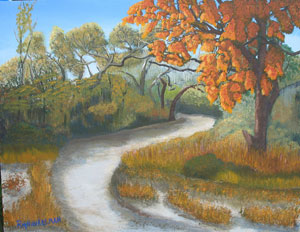Robert Hinkelman ’63 coauthors Perpetual Innovation, exhibits art in galleries from NYC to Florida
 The leap from patents to painting is wide, requiring a person specializing in both to have a technical and artistic bent not often found in one individual. For Robert Hinkelman ’63, neither area was an intentional focus; he began painting as a hobby and started studying the patent system in the course of job responsibilities.
The leap from patents to painting is wide, requiring a person specializing in both to have a technical and artistic bent not often found in one individual. For Robert Hinkelman ’63, neither area was an intentional focus; he began painting as a hobby and started studying the patent system in the course of job responsibilities.
“I was working in Buffalo, where there is no real spring,” he says. “I started painting as a cure for cabin fever.”
Hinkelman was transferred to New Jersey and made the decision to continue his painting, as well as to begin taking courses to advance his skills. His painting became more serious.
“When I was working, I would take a painting into the office and look at it all day to see what had to happen,” he says. “Every once in a while an employee would ask to buy one and it eventually occurred to me that this could be more than a hobby.”
He chose to work almost exclusively in acrylics because they dry quickly and do not require odorous chemical thinners.
“When our kids were growing up, we were running around a lot.” he says. “I also traveled quite a bit during that time. I found I could do a good amount of work in that medium in a short time.”
As with most artists, Hinkelman’s style has changed in a way that reveals how his technical and artistic duality evolved.
“Early on I was an engineer for each painting,” he says. “I did grids to dissect the photo and I placed everything in exacting proportions and ratios. A number of people prompted me to let go and just paint. So I evolved away from that. The woman I am mentoring with now, Kelly Arnold at the Elliott Museum, is far more free form.
“While painting is largely about light and its effect, I am currently working to emphasize the ways light impacts objects in its path to draw the viewer’s attention and reaction. I attempt to bring nature’s moods to the canvas. My work centers on oceans, marshes, creeks, the desert, mountains in winter, birds of prey, and sand dunes. My goal is to make my paintings real enough that the viewer senses that he or she is ‘looking out a window’ at the sky, the snow, the marsh, the sea.”
Hinkelman has exhibited at art galleries from Manhattan to Florida, and maintains an online gallery at www.rmhinkelmanart.com.
“The advantage of the online gallery is that it is posted through a portal that gets good recognition in search engines,” he says. “Displayed this way, my work gets more exposure nationwide than it would in galleries only.”
Hinkelman and Elmer B. Hall recently wrote and self-published Perpetual Innovation: A Guide to Strategic Planning, Patent Commercialization and Enduring Competitive Advantage.
“Perpetual Innovation describes the strategic planning process necessary for managers and inventors to bring protected technologies to market,” he explains.
Like his transformation from hobbyist painter to gallery artist, Hinkelman became an author on such a specialized subject as part of a natural evolution.
“The book emanated from my career at AT&T,” he explains. “I was there from 1963 to 1998. Our children’s eyes glaze over when they think of staying at one place all that time, because it is not so common to do that in a career today.”
Hinkelman had to learn engineering and transmission theory in order to function in his career at AT&T. This knowledge was especially valuable as he began working for the individual who held the patent for 1-800 service, a patent AT&T owned.
“Our jobs were to protect the patent on behalf of AT&T. When it broke up, the patents were no longer publicly licensed,” he says. “I moved into the Intellectual Property division and the idea of the book grew from there.”
Using patents as a barrier to competitive entry became a key concept of the book, along with advice for guiding all necessary departments in a company through the patent process smoothly and successfully.
“The book focuses on the business side of patent commercialization, those decisions that involve everyone in the organization, not just the patent attorneys and the scientists. The title reflects the fact that to stay on top of product market share means perpetually adding new features to a product — features that can be patented.”
Perpetual Innovation is available in both bound and electronic versions at www.lulu.com, allowing Hinkelman once again to use the internet for marketing his work.
A history graduate, Hinkelman says his memorable professors included the late Al Gendebien ’34, professor emeritus of history, College archivist emeritus, and author of The Biography of a College: A History of Lafayette College 1927-78. Most memorable was English professor William W. Watt.
“He was a character of the first order – education and entertainment rolled into one,” says Hinkelman.
 The leap from patents to painting is wide, requiring a person specializing in both to have a technical and artistic bent not often found in one individual. For Robert Hinkelman ’63, neither area was an intentional focus; he began painting as a hobby and started studying the patent system in the course of job responsibilities.
The leap from patents to painting is wide, requiring a person specializing in both to have a technical and artistic bent not often found in one individual. For Robert Hinkelman ’63, neither area was an intentional focus; he began painting as a hobby and started studying the patent system in the course of job responsibilities.